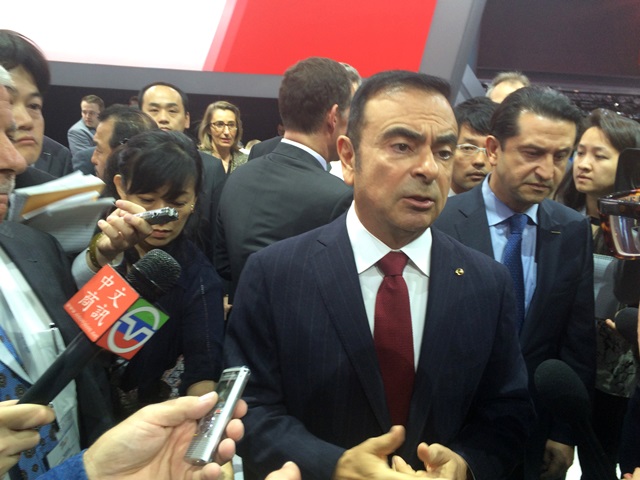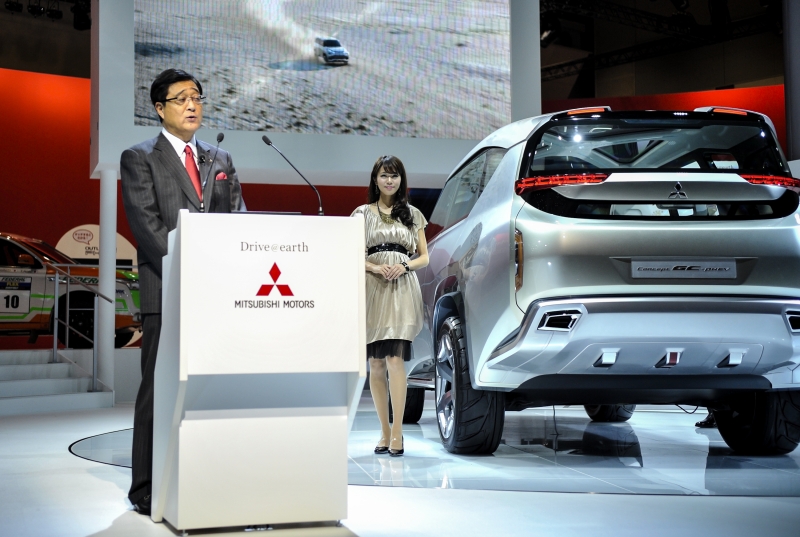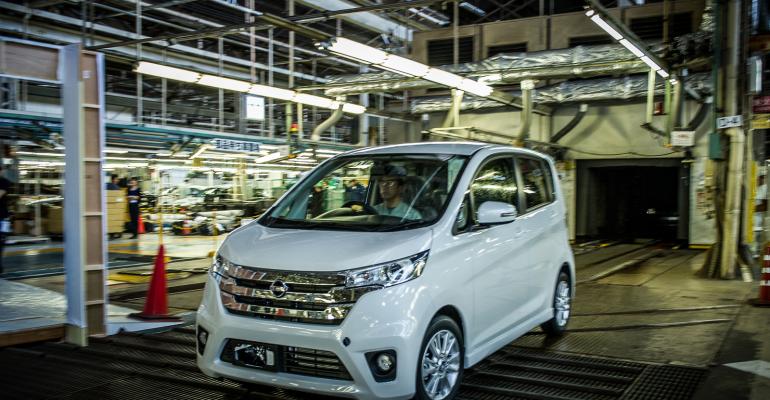TOKYO – Renault-Nissan Alliance CEO Carlos Ghosn predicts the acquisition of a controlling stake in Mitsubishi could vault the individual also-rans into the top tier of global automakers with annual sales of up to 10 million units.
Synergies – the sharing of expertise among separate entities to increase efficiency – is a word frequently used by Ghosn and Mitsubishi CEO Osamu Masuko to identify their companies’ respective manufacturing, R&D and other strengths.
“Everybody wins,” Ghosn says at a recent news conference announcing completion of Nissan’s ¥237 billion ($2.3 billion) purchase of a 34% equity stake in Mitsubishi, 17 years after forming a similar partnership with French automaker Renault.
The deal was sealed five months after Mitsubishi informed Japanese regulators of misstating the fuel economy mainly of four minicars known in Japan as kei cars. The scandal plunged Mitsubishi into the red after a decade of profitability under Masuko’s leadership.
Mitsubishi still has more than ¥250 billion ($2.4 billion) in the bank – but not enough to achieve management’s long-term strategic objectives.

The seeds of the merger were sown in 2011 when Mitsubishi and Nissan formed a joint venture to produce 0.66L kei cars at Mitsubishi’s Mizushima plant in western Japan. The Nissan-badged Dayz and Dayz Roox, along with Mitsubishi’s eK Wagon and eK Space, comprise most of the vehicles caught in the fuel-economy scandal.
Ghosn says he hopes to duplicate the success of his Nissan revival plan based upon Renault’s $5.4 billion cash infusion in the Japanese automaker in 1999.
“Nissan struggled for 10 years,” he recalled, “(and) tried two or three times to restructure its business. Had Renault not made the commitment, we never would have had the Nissan revival plan. We know through our experience with Renault what can be achieved.”
Working last year with Renault, which holds a 43.4% stake in Nissan, the Japanese automaker generated synergies of €4.4 billion ($4.8 billion), the CEO says. With the addition of Mitsubishi to the alliance, Ghosn expects synergies to grow to €5.5 billion ($6.0 billion) in 2018.
Blending Best of Both Worlds
“Operationally,” Ghosn says, “we have already identified synergies that will benefit both companies, (including) Nissan’s ability to harness Mitsubishi’s know-how in the kei or minicar segment, to adopt systems from Mitsubishi for plug-in electric vehicles as part of Nissan’s commitment to intelligent mobility, to capitalize on Mitsubishi’s strengths in pickup trucks to jointly become a powerhouse in the segment and to build on Mitsubishi’s successful ASEAN operation.
“These synergies are expected to generate improvements in operating profit equivalent to a pretax return on the investment paid today of 10% for fiscal 2017 and 25% in fiscal 2018 and beyond – which means that these synergies are now estimated at ¥24 billion ($228 million) in fiscal 2017 and ¥60 billion ($570 million) in fiscal 2018 and beyond,” Ghosn says.
Beyond Nissan’s controlling 34% stake in Mitsubishi, three Mitsubishi Group companies – Mitsubishi Heavy Industries, Mitsubishi Corp. and The Bank of Tokyo-Mitsubishi, each hold a 17% stake. The new organization will be ratified at a Dec. 14 shareholders meeting.
Masuko, who turned Mitsubishi into a money-maker during his 11-year tenure as president, will remain CEO after Ghosn talked him out of joining other top executives in the wake of the mileage-cheating scandal.

“I understand that observers and commentators may have a different opinion” about keeping Masuko in charge of Mitsubishi, Ghosn says. “But this is a business. And in the best interest of Mitsubishi and its shareholders, Masuko-san should stay. That’s it.”
Nissan on Nov. 1 assigned four executives to Mitsubishi’s board of directors including new Chief Operating Officer Trevor Mann and Executive Vice President Mitsuhiko Yamashita.
Yamashita previously served as executive vice president in charge of Nissan’s global R&D operations, while Mann was chief performance officer for the world’s fourth-largest automaker by sales.
Mitsubishi’s fortunes nosedived when the mileage-cheating scandal broke in April.
In the business year ending March 31, three weeks before Mitsubishi notified Japanese regulators of testing irregularities involving 0.66L kei cars including models built for Nissan, the automaker reported record earnings of ¥138.4 billion ($1.3 billion) on sales of ¥2.3 trillion ($21.5 billion). Sales were at an 8-year high, the company was free of debt with ¥462.4 billion ($4.4 billion) in cash on hand.
Then the mileage-cheating scandal, which led to the recall of 625,000 cars in Japan, turned things upside-down.
Mitsubishi delayed releasing its fiscal-2016 earnings forecast until late June after taking a ¥19.1 billion ($181 million) extraordinary loss, which it credited to the previous fiscal year. It optimistically predicted earnings of ¥25 billion ($237 million).
The automaker subsequently revised its forecast downward to ¥28.0 billion ($266 million) in the red on 19% lower sales of ¥1.8 trillion ($17.4 billion). It took another extraordinary loss, this one for ¥165 billion ($1.6 billion), to cover tax-credit refunds to both Mitsubishi and Nissan customers, losses incurred by suppliers and other related expenditures.
Mitsubishi Finances Bloodied But Not Bowed By Scandal
Masuko, in a June interview with WardsAuto following the mileage-cheating disclosures, was optimistic fiscal-2017 earnings for the business year beginning April 1 would recover to fiscal 2015’s record levels. That now seems less likely.
The shortfall is not surprising, considering domestic production, heavily affected by the scandal mainly involving four models (Mitsubishi’s eK wagon and eK Space and Nissan’s Dayz and Dayz Roox), fell nearly 25% from the previous year. Sales, mostly 0.66L minis, were down 37%.
Sales were suspended in April and did not resume until Oct. 1.
In his June interview with WardsAuto, Masuko outlined several general areas of potential collaboration, including Nissan using Mitsubishi’s Southeast Asian manufacturing base and Mitsubishi turning to Nissan for its autonomous-driving technology.
Ghosn and Masuko discussed synergies and their effect on the automakers’ bottom line in greater detail during an October news conference announcing Nissan’s acquisition of a controlling stake in Mitsubishi.
Ghosn calls these joint activities “low-hanging fruit,” adding the automakers have yet to estimate potential synergies involving Renault. “But ultimately we will focus on joint purchasing and plant operations, deeper localization, common vehicle platforms, technology sharing and expansion of our combined presence in global auto markets.”
Masuko adds: “So far we have had only discussions with Nissan. But going forward as a full member in the Renault-Nissan Alliance, we will also discuss synergies with Renault. Diesel engines, for instance, an area in which Renault is strong.”
Masuko estimates Mitsubishi will benefit from ¥25 billion ($238 million) of synergies annually beginning in fiscal 2017. “We expect to generate synergies in purchasing, specifically from cost reduction through benchmarking and joint procurement of raw materials.
“In production, we will produce differential gears for Nissan at our Mizushima plant to help enhance utilization, while in engineering we expect to jointly develop autonomous-driving technologies as well as common platforms and powertrains to comply with increasingly stringent environmental and safety regulations.
“In particular,” Masuko says, “Mitsubishi’s plug-in hybrid technology will be the alliance standard to be shared by Nissan and Renault, which will have the added benefit of bringing down costs. Lastly, in markets like Australia Mitsubshi will work with Nissan’s sales and finance companies to offer retail loans, leases and dealer financing.
“These initiatives will result in greater sales volumes and a stronger bottom line.”
Nissan Looks to Mitsubishi to Open Doors to Asian Markets
Ghosn is not happy with Nissan’s performance in the ASEAN region.
“We think that Mitsubishi is doing a much better job than in many countries in the region,” he says. “We believe that the collaboration will help us in many areas to shore up our own level of competitiveness.
“This is certainly a huge area of opportunity for Nissan and an area where synergies can work the other way.”
The CEOs offer a specific example: Mitsubishi’s new Pajero Sport plant under construction in West Java, Indonesia.
“Both Mitsubishi and Nissan will sell this vehicle in ASEAN countries,” Masuko says. “Therefore, Mitsubishi can increase production volume, in turn reducing logistical, raw material and other costs and improving the profitability of the operation.”
Elsewhere in the region, the automaker is expanding capacity in the Philippines and China. Several years ago it opened a plant in Thailand where it assembles Mirage hatchbacks and sedans both for the ASEAN market and export, including to the U.S.
In fiscal 2015, Mitsubishi sold 1.1 million vehicles globally. One of three was sold in Asia, excluding Japan. More importantly, the Asia market accounted for more than half of global earnings during the year: ¥74.9 billion ($715 million) of a total ¥138.4 billion ($1.3 billion).
Despite the damage to Mitsubishi’s brand and bottom line inflicted by the mileage-cheating scandal, the automakers will continue to work together in the 0.66L minicar segment.
“Obviously, cooperation will continue,” Ghosn says. “We (Nissan) need to compete better in Japan.”
Nissan ranks as Japan’s fifth-largest brand behind Toyota, Honda, Suzuki and Daihatsu. That market accounted for only 11% of Nissan’s global sales total in the most recent fiscal year. Nissan sold only 572,624 vehicles in Japan last year, 34% of which were minis, most supplied on an OEM basis by Mitsubishi.
Continuing the previous arrangement, Mitsubishi will take the lead in kei-car development and production.
Sharing EV, PHEV Expertise
Nissan, the world’s leading manufacturer of battery-electric cars, has yet to introduce a plug-in hybrid. Mitsubishi’s Outlander PHEV was the global leader in the segment in 2015 on sales of 40,990 units, outpacing the Chevrolet Volt and other competing models.
Prior to forming the alliance, Mitsubishi had three new PHEVs in the pipeline.
“The cost of development will be shared,” Ghosn says. “Parts will be shared. Mitsubishi can lower its investment (contributing to) lower cost and bigger production volume. Nissan and Renault can lower their investment and (accelerate bringing) the technology to the market. Everybody wins.
“In reverse,” Ghosn explains, “Nissan’s autonomous-drive technology is very well advanced. Mitsubishi needs autonomous drive. The technology Nissan has developed is going to be shared with Mitsubishi, which in turn will pay a smaller price and develop the technology much faster than if it were to do so by itself.
“The same principle is involved in connected cars, for powertrains and for transmissions.”
Mitsubishi, along with rival Suzuki, are minor shareholders in Jatco, Nissan’s transmission subsidiary and the world’s leading manufacturer of CVTs.
“The expanded alliance (Nissan, Renault and Mitsubishi) will be one of the largest automotive groups in the world with annual sales of 10 million units (serving) every market segment and every geographic region,” Ghosn says. “If we act smartly, this can be a significant advantage. With 10 million cars (sold annually), we have a handicap to nobody.”
Toyota and Volkswagen are the only other automakers to have sold 10 million units in a year.
Ghosn is confident Mitsubishi will be successfully restructured under Nissan.
“Because Mitsubishi has competent people who like their company, and with more transparency, cross-functional work and best-practices exchange, we can fix it,” Ghosn says. “Nissan will not spare anything to support Mitsubishi during this period, especially now that we’re the main shareholder.
“It’s going to be difficult. It will require lots of change. There will be many tough decisions.”
Ghosn details his leadership roles at the three companies: “In Renault, I am chairman and CEO, responsible for both governance and performance of the company. In Nissan, I am chairman and CEO, again responsible for governance and performance.
“In Mitsubishi, I am chairman, responsible for making sure that there is strong governance and transparency inside the company, that there are budgets and midterm plans, and that Mitsubishi’s relationship with Nissan and Renault is smooth and effective.”
But, he adds, management responsibility for running Mitsubishi rests with CEO Matsuko.
“It is my responsibility as chairman to help Masuko-san navigate inside this organization and get the best out of it,.” Ghosn says.
New Duties Prompt Ghosn to Name “Co-CEO” at Nissan
To avoid overextending himself, Ghosn has promoted Hirota Saikawa to “co-CEO” at Nissan. Saikawa, reportedly on the short list to eventually succeed Ghosn at Nissan, currently is executive vice president-global purchasing, manufacturing, supply-chain management, R&D and customer satisfaction.
“Masuko-san needs support and advice to help facilitate relationships with other entities in the alliance,” Ghosn says, stressing he needs to “make sure that we are not losing focus on Nissan’s own performance.”
Ghosn says Saikawa’s service as co-CEO will ensure Nissan delivers on its midterm plan and performance.
“We’re (also) taking this step because of the Mitsubishi task and responsibility. There will be no difference between what I say and what Hirota-san does. We need to adapt the organization.”
Nissan will make other changes including expanding Nissan North America Chairman Jose Munoz’s duties to include chief performance officer.
When WardsAuto interviewed Masuko in June, the Mitsubishi CEO was not clear about what role, if any, he would play in the new organization. Having stayed on at Ghosn’s insistence, Masuko will serve indefinitely implement Mitsubishi’s new midterm plan.
Ghosn says Masuko’s continued presence was a condition for creation of the alliance.
Masuko “didn’t want to stay on the job,” Ghosn says. “He told me many times that he wanted to resign and take responsibility for what had happened. I want to make it very clear. I asked him to stay.
“This was a very important condition for us to make the alliance because Nissan trusts Masuko-san. I asked him (to stay) for the best interest of Mitsubishi Motors and the alliance. He agreed.”
Masuko’s first request when he approached Ghosn in April was for help in rebuilding Mitsubishi’s product-development and engineering operation. Ghosn obliged by sending former Executive Vice President Mitsuhiko Yamashita, who had headed Nissan’s global R&D operation for more than a decade before retiring in June 2015 and becoming a technical advisor.
“Yamashita-san is currently leading the effort to transform our engineering operation. To this end, he is reviewing human-resource requirements and has determined that there is a shortage,” Masuko says, noting the retired executive already has identified 31 issues of concern.
“We’re still waiting for his final report. Based on that we will seek further assistance from Nissan or perhaps turn to the market.”
Ghosn is clear that it no longer will be business as usual at Mitsubishi.
“Because there is an emergency here, we must insure that everything is put in place to avoid events like the one related to fuel economy and emissions so that they won’t happen again,” Ghosn says.





